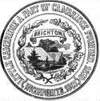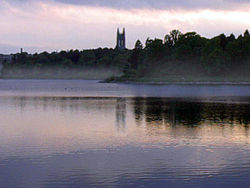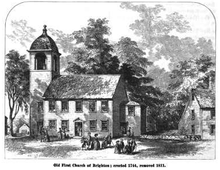- Brighton, Massachusetts
-
Brighton — Neighborhood of Boston — The Chestnut Hill Reservoir is located in the Brighton neighborhood. (Boston College can be seen in the background). 
SealNickname(s): Little Cambridge, South Cambridge, Third Parish (all archaic) Country United States State Massachusetts County Suffolk Neighborhood of Boston Settled 1630 Incorporated February 24, 1807 Annexed by Boston January 5, 1874 Population – Total 43,887 Time zone Eastern – Summer (DST) Eastern (UTC) Zip Code 02135 Area code(s) 617 / 857 Brighton is a dissolved municipality and current neighborhood of Boston, Massachusetts, United States,[1] and is located in the northwest corner of the city. It is named after the town of Brighton in the English city of Brighton and Hove. For its first 160 years Brighton was part of Cambridge and was known as “Little Cambridge." Throughout much of its early history it was a rural town with a significant commercial center at its east end. Brighton separated from Cambridge in 1807 after a bridge dispute and was later annexed to Boston, in 1874.[2] It is now a large community jointly with the adjacent neighborhood of Allston. Its population is predominantly white and Asian, with smaller numbers of Latinos and African Americans.
Contents
History
In 1630, land comprising present-day Allston-Brighton and Newton was assigned to Watertown.[3] In 1634, the Massachusetts Bay Colony transferred ownership of the south side of the Charles River, including present-day Allston-Brighton and Newton, from Watertown to Newetowne,[3] later renamed Cambridge.
In 1646, Reverend John Eliot established a “Praying Indian” village on the present Newton-Brighton boundary, where resided local natives converted to Christianity. The first permanent English settlement came as settlers crossed the Charles River from Cambridge, establishing Little Cambridge, the area's name before 1807.
Before the American Revolutionary War, Little Cambridge became a small, prosperous farming community with fewer than 300 residents. Its inhabitants included wealthy Boston merchants such as Benjamin Faneuil (after whom a street in Brighton is named).
A key event in the history of Allston-Brighton was the establishment in 1775 of a cattle market to supply the Continental Army. Jonathan Winship I and Jonathan Winship II established the market, and in the post-war period that followed, the Winships become the largest meat packers in Massachusetts.
The residents of Little Cambridge resolved to secede from Cambridge when the latter's government made decisions detrimental to the cattle industry and also failed to repair the Great Bridge linking Little Cambridge with Cambridge proper. Legislative approval for separation was obtained in 1807, and Little Cambridge renamed itself Brighton.
In 1820, the horticulture industry was introduced to the town. Over the next 20 years, Brighton blossomed as one of the most important gardening neighborhoods in the Boston area. The businessmen, however, did not neglect the cattle industry. In 1834, the Boston & Worcester Railroad was built, solidifying the community's hold on the cattle trade. By 1866, the town contained 41 slaughterhouses.
In October 1873, the Town of Brighton, in Middlesex County, voted to annex itself to the City of Boston in Suffolk County, and in January 1874 Brighton officially became a neighborhood of the City of Boston. Allston-Brighton’s population grew tremendously in the next half century, rising from 6,000 in 1875 to 47,000 by 1925.[4]
Transportation
Brighton is accessible via the B line of Massachusetts Bay Transportation Authority's (MBTA) Green Line as well as its local bus routes (57 - Kenmore Square to Watertown Yard, 64 - Oak Square to Central Square (Cambridge) via Cambridge Street, 65 - Kenmore Square to Brighton Center via Longwood Medical District, 70 - Waltham to Central Square (Cambridge) via Western Avenue and 86 - Cleveland Circle to Harvard Square via Market Street) and inner-express bus routes (501 - Brighton Center to Financial District and 503 - Brighton Center to Copley Square). The C branch of the Green line terminates in Brighton, and the D branch of the Green line runs nearby, though not through Brighton.
While 47% of the population of Brighton drives alone to work, 36% uses mass transit, compared with 71% and 2% respectively for the United States as a whole.[5]
Geography
Brighton is a neighborhood of Boston that is connected to the rest of the city by the Allston neighborhood and is otherwise surrounded by Cambridge, Watertown, Newton, and Brookline. The Charles River separates Brighton from Cambridge and Watertown. According to the Census Bureau, Brighton, defined by zip code 02135, has a population of 43,887 and a land area of 2.78 square miles (7.2 km2).
Brighton is, for the most part, administered jointly with the adjacent neighborhood of Allston (zip code 02134). The two are often referred to together as "Allston-Brighton" (and by some as "Brighton-Allston"), and (also according to Census Bureau data) have a combined population of 65,276 and a land area of 4.12 square miles (10.7 km2).
 Cemetery and apartment houses along Commonwealth Avenue, Brighton, near Chandler's Pond
Cemetery and apartment houses along Commonwealth Avenue, Brighton, near Chandler's Pond
Demographics
As of 2007, the estimated population of Brighton is 42,789, a 2.81% loss from the 2000 Census. The population density is 14,797 per mi2, slightly higher than the citywide average of 12,166 per mi2. The median age is 32.2. The largest measured age cohort is 25-34, which comprises 32.52% of the population. (Note: depending on methodology, college students might not be counted.) Fifty-nine percent of the population have never been married.[6]
The population was 78% white, 12% Asian American, 3.5% black or African American, and nearly 7% Hispanic of any race.[6]
Thirty-three percent of Brighton has graduated from a four-year college.[7]
The median home price is $495,000 compared with $217,200 for the country as a whole, and the cost of living is 30% higher than the national average.[8] Brighton has a comparatively older housing stock. The median home age was 58 years and 42% of homes were built before 1939.[9]
The largest religious group (45%) is Catholic, with Protestants and other Christians making up the second-largest, at 10% of the population. The next largest religious identification is Judaism (4%), with Islam at 2%.[10]
Education
Brighton is host to many public schools, including Winship Elementary School, Edison School, and Mary Lyon School. One of these is Brighton High School. Mount St. Joseph Academy is a private high school located within the boundaries of the locality. The EF International Language School, an English and college preparatory school for international students, is located on Lake Street.
Brighton is host to the Everest Institute, Saint John's Seminary and portions of Boston College and Harvard University. The area is also close to other colleges, including Boston University, and houses many of their students and faculty.
See also the List of colleges and universities in metropolitan Boston.
Notable residents
- Michael Bloomberg, mayor of New York City, born in Brighton
- William F. Galvin, Massachusetts Secretary of State
- Joe Kennedy, son of the late Robert Kennedy
- Patrick J. Kennedy, former U.S. Congressman for Rhode Island's 1st district
- John Krasinski, film actor, director, writer
- Dennis Lehane, author of Mystic River and many other Boston-set novels
- Mr. Lif, political rapper
- James Lynch, member of the Dropkick Murphys
- Mike Milbury, former coach and player of the NHL's Boston Bruins
- Steve DeOssie, former professional football player for the NFL's New York Giants and New England Patriots
- Fred Salvucci, former Massachusetts Secretary of Transportation
- A.J. Soares, current player and 2011 first round draft pick of Major League Soccer's New England Revolution
- Charles Richard Stith, former U.S. Ambassador to Tanzania
Footnotes
- ^ "Boston's Neighborhoods: Allston/Brighton". Boston Redevelopment Authority (BRA). 2010. http://www.bostonredevelopmentauthority.org/neighborhoods/neighborhoods.asp?action=ViewHood&HoodID=1. Retrieved August 17, 2010.
- ^ http://www.bahistory.org/HistoryBrighton.html
- ^ a b "History of Brighton-Allston". http://www.bahistory.org/HistoryBrighton.html. Retrieved 2008-01-29.
- ^ http://www.brightonbot.com/history.php
- ^ Brighton, Massachusetts (MA) transportation resources - Sperling's BestPlaces
- ^ a b Brighton, Massachusetts (MA) demographic resources - Sperling's BestPlaces
- ^ Brighton, Massachusetts (MA) education and school resources - Sperling's BestPlaces
- ^ Brighton, Massachusetts (MA) population and demographics data - Sperling's BestPlaces
- ^ Brighton, Massachusetts (MA) real estate resources - Sperling's BestPlaces
- ^ Brighton, Massachusetts (MA) religion resources - Sperling's BestPlaces
References
- Brighton Board of Trade history page
- Dr. William P. Marchione, "A Short History of Allston-Brighton"
- Dr. William P. Marchione, The Bull in the Garden (1986)
- Dr. William P. Marchione, Images of America: Allston-Brighton (1996)
- Excerpts from "Historical Allston-Brighton"
- 1871 Atlas of Massachusetts. by Wall & Gray.Map of Massachusetts. Map of Middlesex County.
- History of Middlesex County, Massachusetts, Compiled by Samuel Adams Drake, published 1879, Volume1 page 278 Brighton, by Rev. Frederic Whitney. Note Brighton was originally part of Middlesex County before joining Boston which is Suffolk County.
External links
Neighborhoods in Boston Allston/Brighton · Back Bay · Bay Village · Beacon Hill · Charlestown · Chestnut Hill · Chinatown · Columbia Point · Dorchester · Downtown Crossing · East Boston · Fenway–Kenmore · Financial District · Forest Hills · Fort Point · Government Center · Hyde Park · Jamaica Plain · Leather District · Longwood · Mattapan · Mission Hill · North End · Readville · Roslindale · Roxbury · South Bay · South Boston · South End · West End · West Roxbury

Categories:- Neighborhoods in Boston, Massachusetts
- Former municipalities in Boston, Massachusetts
- Defunct towns in Massachusetts
- United States places with Orthodox Jewish communities
Wikimedia Foundation. 2010.



